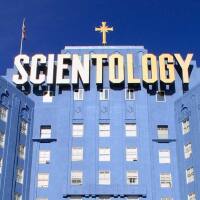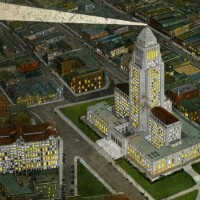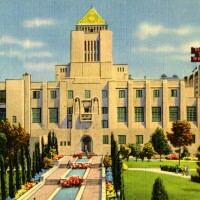Los Angeles in Buildings: The Bradbury Building

Though most moviegoers will have seen a lot of Bradbury Building, they may not recognize it as a landmark of Los Angeles architecture – unless, of course, they've seen Thom Andersen's documentary “Los Angeles Plays Itself,” which devotes a solid block of its nearly three-hour runtime to the many roles it has played onscreen. “The movies discovered the Bradbury Building before the architectural historians did,” says its narrator. “The earliest appearance I know came in 1943: in ‘China Girl,’ it played the Hotel Royale in Mandalay, Burma. The following year, in ‘The White Cliffs of Dover,’ it played a London military hospital overflowing with wounded soldiers.”
Later films placed the Bradbury Building elsewhere: “Caprice” in Paris, “Wolf” in New York, “Murder in the First” in San Francisco. These and other roles may demonstrate the structure's versatility, but they've surely also caused some confusion as to its actual location. Anyone seeking to satisfy an interest in Los Angeles architecture, though, will hear about the Bradbury Building's place in its canon before they hear about anything else. It found that place thanks, in large part, to its celebration by influential Southern California architectural historian and Arts & Architecture Magazine contributor Esther McCoy, who launched her campaign in 1953, a decade after the building made its cinematic debut in “China Girl” and six decades after it first opened.



“There is nothing whatever accidental about it,” goes the quote from the magazine proudly included, for a time, on a handout provided to the Bradbury's visitors. “There are no afterthoughts. It is a forever young building, out of a youthful and vigorous imagination. But it has left nothing to chance. Stairways leap into space because of endless calculations. The skylight is a fairy tale of mathematics.” This praise, like almost all the praise heaped upon the building ever since, focuses on its interior. When observers mention the exterior at all, they do so only do dismiss it: David Gebhard and Robert Winter's “Architectural Guidebook to Los Angeles” describes its style as “mildly Romanesque,” but only in a parenthetical aside after they've first pronounced it “dull.”
Any work of the Bradbury Building's distinction, splendor, and sheer cost will get people telling stories.
Its interior, and specifically its Victorian court lobby, made the Bradbury Building a movie star. The patterned Italian marble staircases, Mexican floor tiles, intricate French wrought-iron work, operator-staffed birdcage elevators, and the then-largest plate-glass windows in Los Angeles all under a fifty-foot-high atrium made its image as a refuge of architectural taste and dignity in a city elsewhere regarded even when the building opened in 1893 as an unprecedented concentration of architectural vulgarity. It all came together at the behest of millionaire Lewis L. Bradbury, who, having made his fortune in gold-mining, spared no expense in the construction of this monument to his legacy, one originally estimated at $175,000 and opened just months after his death at the final cost of a then-staggering $500,000.
Any work of the Bradbury Building's distinction, splendor, and sheer cost will get people telling stories. “In an architecture of steel and glass, marble, tile and movement, George Wyman envisioned and presented the material dream of Southern California as a technology flooded by sunlight,” writes California historian Kevin Starr. Wyman, according to the widely repeated legend, drew inspiration for the design from “Looking Backward,” a futuristic novel by the utopian visionary Edward Bellamy which became a popular sensation in the early 1890s. Bellamy conjures up “a twentieth-century public building” offering “a vast hall full of light, received not alone from the windows on all sides, but from the dome, the point of which was a hundred feet above. Beneath it, in the centre of the hall, a magnificent fountain played, cooling the atmosphere to a delicious freshness with its spray. The walls and ceiling were frescoed in mellow tints, calculated to soften without absorbing the light which flooded the interior.”

The Bradbury Building's atrium may only rise to half that height – strikingly smaller, like so many movie stars, in real life than on the silver screen – and it may lack a fountain, but a comparison of passage and building makes the influence seem plausible. Some may find harder to swallow the story of how Wyman came to accept the commission in the first place. A draftsman employed for five dollars a week in the office of architect Sumner Hunt, whom Bradbury had originally hired up to draw up a plan for his building, Wyman somehow impressed the millionaire enough to give him second thoughts. When Bradbury offered Wyman the job instead, Wyman agonized over the morality of the situation, supposedly going so far as to use a planchette, an early form of Ouija board, to contact his dead brother. “Take the Bradbury Building and you will be successful,” the spirit's dangling pencil assured him.
Like many long-lived screen icons, the Bradbury Building has endured almost as many years of irrelevance and dissolution as it has enjoyed years of celebration.
This tale goes back to McCoy, who, in preparing that sexagennial reflection on the Bradbury Building, contacted Los Angeles-based science-fiction author Ray Bradbury to ask whether he had any connection to Lewis Bradbury, and thus to the building. He sent her to Forrest J. Ackerman, his agent as well as a formidable collector who stood as the tallest pillar of Los Angeles' science-fiction community – and who also happened to be Wyman’s grandson. Personally in possession of Wyman's encouraging note from the great beyond, Ackerman provided those details about the utopian novel, the planchette, and so on. As to how much all of it actually led Wyman to alter the design that Hunt had come up with before the commission changed hands, no evidence remains.
Still, the Bradbury Building's success spurred Wyman on to complete his architectural education through correspondence courses, though he would never again produce a structure of equal importance. Nor would Hunt, for that matter, and neither man lived to see the work for which they now share credit show up in the movies. But like many long-lived screen icons, the Bradbury Building has endured almost as many years of irrelevance and dissolution as it has enjoyed years of celebration. Decades of mild neglect allowed Ridley Scott and his collaborators, envisioning the Los Angeles of 2019, to cast it as the leaky, trash-strewn ruin it played in “Blade Runner,” arguably its most memorable role of all (and not just because of the plaque that has long commemorated it on the wall of the building itself).

That was in the early 1980s, a time when filmmakers had grown used to treating the whole of downtown Los Angeles, not just its oldest commercial building, as an urban wasteland-cum-studio backlot. “The homeless population of downtown L.A. gawked at our helicopters flying through the streets, literally fifty feet above the pavement, in between buildings and down alleys,” remembers John Badham, who in 1983 directed the contemporary Los Angeles-set “Blue Thunder.” The cinematic uses of the Bradbury as explicitly a Los Angeles building have grown, over the decades, to outnumber those that pretend it elsewhere: the noir classic “D.O.A.,” whose climactic showdown plays out there; “Marlowe,” which installs its titular private detective in a Bradbury office; “The Artist,” in which it evokes silent-era Hollywood; “500 Days of Summer,” in whose final scene the aspiring architect protagonist arrives there to receive, perhaps, both the job and the girl of his dreams.
The continuing cinematic and non-cinematic use of the Bradbury Building, as well as the continuing pilgrimages by those interested in its place in film and architectural history, owes something to the $7 million restoration undertaken in 1991 by developer Ira Yellin and architect Brenda Levin, who even found a long-term office tenant in the Los Angeles Police Department's Internal Affairs Division. An early proponents of the revival of downtown Los Angeles, Yellin, who died in 2002 just before that revival got into full swing, also took on as a project the Million Dollar Theater on the other side of Broadway (also highly visible in “Blade Runner”) and the attached Grand Central Market. Since then, the Bradbury’s still-glorious, still-surprising interior has symbolized the Los Angeles accessible only to those willing to look beyond the city's often nondescript, even uninviting surfaces for the wonders within.


